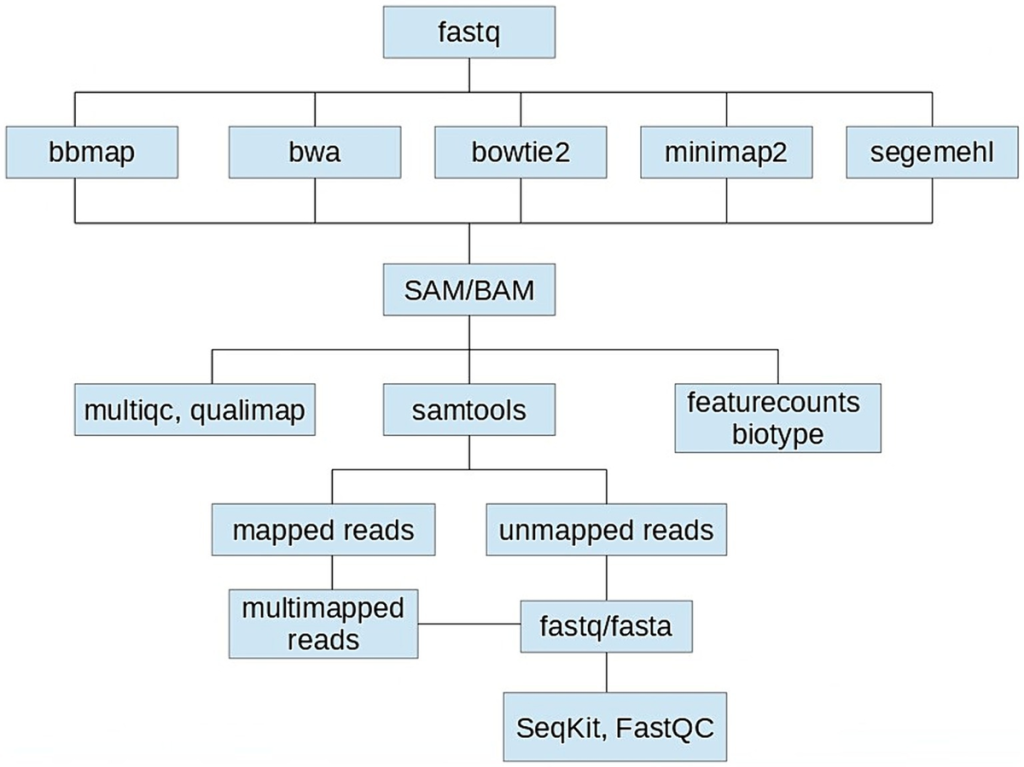sequence alignment is a core step in analyzing next-generation sequencing (NGS) data, where tools like BWA, Bowtie, and minimap2 play a critical role. These aligners map sequencing reads to a reference genome, enabling downstream analysis like variant calling or gene expression profiling. While all three serve a similar purpose, they are optimized for different data types and use cases, especially with the rise of long-read sequencing technologies that demand faster, more versatile, and accurate alignment tools.
Minimap2 stands out as a modern aligner tailored for long-read technologies like PacBio and Oxford Nanopore, although it also handles short reads. In contrast, BWA and Bowtie were originally designed for short-read platforms such as Illumina. These differences in design lead to significant variations in speed, accuracy, memory usage, and application scope. Understanding how minimap2 compares to BWA and Bowtie helps researchers choose the right tool for their specific sequencing data and analysis goals.
Overview of Each Tool
Minimap2 Overview
Minimap2 is a highly efficient sequence alignment tool widely recognized for its performance with long-read sequencing data generated by platforms such as PacBio and Oxford Nanopore. It is designed to handle noisy, variable-length reads with high accuracy while maintaining exceptional speed. The algorithm behind minimap2 allows it to align reads to large genomes, making it ideal for whole-genome assembly, long-read mapping, and spliced alignment in RNA sequencing. Unlike many long-read mappers, minimap2 also supports short-read data, offering a flexible and scalable solution for various genomic workflows. Its performance in aligning high-error-rate long reads while retaining low memory usage positions it as a modern, high-throughput aligner in the era of third-generation sequencing.
BWA Overview
BWA, short for Burrows-Wheeler Aligner, is a widely adopted sequence alignment software particularly optimized for short-read data, such as those generated by Illumina sequencers. It supports several algorithmic variants, including BWA-backtrack for older short-read protocols and BWA-MEM, which is currently the most recommended mode due to its improved support for longer reads and better handling of insertions and deletions. BWA-MEM is suitable for aligning reads up to several hundred base pairs and is frequently used in variant calling pipelines and whole-exome sequencing projects. Its accuracy and robustness make BWA a trusted tool for researchers working with high-throughput short-read datasets where precision and stability are essential.
Bowtie Overview
Bowtie is an ultrafast, memory-efficient aligner specifically tailored for aligning short DNA sequences to large reference genomes. Known for its compact index and ability to operate under low memory conditions, Bowtie has become a popular choice for large-scale genomics projects involving millions of reads. Bowtie1 is optimized for perfect or near-perfect matches, offering exceptional speed at the cost of lower tolerance for mismatches. Its successor, Bowtie2, improves on sensitivity and supports gapped alignments, making it more versatile while maintaining speed. Bowtie remains a top performer for applications where speed and low resource consumption are critical, such as ChIP-seq and small RNA-seq data analysis.
Key Differences Between Minimap2, BWA, and Bowtie
Input Data Type Support in Minimap2, BWA, and Bowtie
When comparing Minimap2 with aligners like BWA and Bowtie, one of the most fundamental differences lies in the type of input sequencing data they are designed to handle. Minimap2 supports both long-read and short-read sequencing data, making it highly versatile for various next-generation sequencing platforms, including PacBio and Oxford Nanopore, as well as Illumina. This flexibility positions Minimap2 as a preferred choice for projects involving complex genomes or noisy reads. On the other hand, BWA is primarily optimized for short reads, especially from high-throughput Illumina sequencers, although its BWA-MEM algorithm provides moderate support for longer reads. In contrast, Bowtie was originally developed for short-read alignment only, and while Bowtie2 extends support to longer reads, it still performs best when used for high-quality short-read data from technologies like Illumina. Therefore, Minimap2 stands out in terms of input compatibility, especially for long-read sequencing workflows.
Speed and Performance Comparison: Minimap2 vs BWA vs Bowtie
The performance and speed of an aligner are crucial when working with large-scale sequencing datasets, and this is where Minimap2 showcases its strengths. Minimap2 is known for its high-speed performance, particularly when aligning long reads or performing genome-to-genome alignments. It can process large datasets quickly while maintaining reasonable memory usage, which is essential in modern genomics. BWA, although reliable and accurate for short reads, tends to be slower, especially when handling longer or more error-prone reads. Its performance is optimized for quality over speed in the context of short-read sequencing. Bowtie, on the other hand, is designed for maximum speed with minimal memory usage, excelling in short-read alignments where throughput is prioritized over sensitivity. For projects that demand fast turnaround times and efficient computing, Bowtie is an effective tool, but for long-read projects, Minimap2 delivers superior speed and efficiency.
Accuracy and Sensitivity Across Minimap2, BWA, and Bowtie
Accuracy and sensitivity are essential metrics in evaluating the effectiveness of sequence aligners. Minimap2 offers a well-balanced approach that maintains both high alignment speed and reasonable sensitivity, even when dealing with noisy long-read data. This makes it suitable for applications such as de novo assembly, structural variant detection, and full-length transcriptome analysis. BWA, particularly the BWA-MEM algorithm, is renowned for its high accuracy with high-quality short reads, making it ideal for variant calling in clinical and research-grade DNA sequencing projects. Bowtie, especially in its first version, was built for speed, which sometimes came at the expense of sensitivity. Bowtie2 improved significantly in this regard, offering a better balance between speed and accurate alignment. However, when compared directly, Minimap2 provides superior performance for complex or error-prone reads, while BWA remains a gold standard for precision in short-read datasets.
Use Case Scenarios: When to Use Minimap2, BWA, or Bowtie
Understanding the ideal use case for each aligner helps researchers choose the right tool for their sequencing projects. Minimap2 is particularly effective for long-read sequencing technologies and supports complex tasks like genome-to-genome alignments, spliced RNA-seq alignments, and mapping reads with high error rates. Its design enables it to handle high-variance data with speed and accuracy, making it highly suitable for modern genomic research involving structural variants and transcriptomics. BWA is the go-to aligner for traditional short-read DNA sequencing projects, such as whole-genome sequencing, exome sequencing, and resequencing studies. It provides a good balance of accuracy and efficiency when working with high-quality reads. Bowtie, due to its lightweight architecture, is ideal for high-throughput short-read alignments where memory usage and processing speed are critical. It performs exceptionally well in projects like small RNA sequencing, metagenomics with short fragments, and large-scale s
Summary Table
Understanding the Purpose of the Summary Table
The summary table serves as a compact, side-by-side comparison that highlights the essential differences between Minimap2, BWA, and Bowtie, three widely used tools in the field of sequence alignment. When working with next-generation sequencing data, researchers often need to choose the right aligner based on their specific data types and analysis goals. This table is designed to help users quickly understand which aligner is best suited for tasks like aligning short reads, handling long-read sequencing technologies, or processing spliced transcripts from RNA-seq experiments.
Tool Suitability Based on Read Type
One of the most critical distinctions in this summary table is the type of sequencing reads each aligner supports best. Minimap2 is optimized for long reads generated by platforms such as Oxford Nanopore and PacBio, while still maintaining support for short-read alignment. In contrast, BWA is best suited for short reads from technologies like Illumina, offering high accuracy in DNA sequencing projects. Bowtie, particularly the original version, is tailored for ultra-fast alignment of short reads and is ideal for high-throughput environments where memory usage and processing speed are top priorities.
Performance and Alignment Speed Comparison
Performance and speed are essential considerations in high-scale genomic data analysis. Minimap2 delivers exceptional speed, especially when dealing with large genomes or long reads, making it a powerful choice for whole-genome comparisons or structural variant detection. BWA offers moderate performance with a focus on accuracy for short-read data, commonly used in variant calling and population genomics. Bowtie emphasizes speed and memory efficiency for short-read datasets, making it well-suited for scenarios where computational resources are limited or massive throughput is required.
Support for RNA-seq and Genome-to-Genome Alignment
Minimap2 stands out by offering advanced features such as spliced alignment for RNA-seq data, which allows it to accurately map reads across exon-exon junctions. This makes it highly effective in transcriptomics and gene expression analysis. Additionally, Minimap2 supports genome-to-genome alignment, enabling researchers to align entire assemblies or chromosomes for comparative genomics. BWA and Bowtie do not offer native support for spliced RNA alignment or whole-genome comparisons, which can be limiting in transcriptome and assembly-level studies.
Choosing the Right Aligner for Specific Applications
The summary table simplifies the decision-making process by outlining each tool’s strengths in a structured format. For example, researchers dealing with long-read sequencing data for de novo assembly or isoform discovery are more likely to benefit from Minimap2. On the other hand, users focusing on short-read variant detection or resequencing projects may find BWA to be the most accurate and reliable option. Bowtie provides a strong advantage in high-throughput, short-read applications where speed and low memory consumption are critical.
Conclusion
Minimap2 differs from BWA and Bowtie mainly in its optimization for long-read sequencing technologies like Oxford Nanopore and PacBio. While BWA and Bowtie were designed with short-read Illumina data in mind, minimap2 excels at handling noisy, variable-length long reads with high speed and decent accuracy. It also supports RNA sequencing with spliced alignment, which is not available in the earlier versions of BWA and Bowtie. This makes minimap2 more versatile for modern sequencing workflows that involve longer and more complex reads.
In contrast, BWA and Bowtie remain highly efficient tools for short-read alignment, with BWA offering better sensitivity and Bowtie being known for its speed and low memory usage. However, they struggle with long-read data and genome-genome alignments, areas where minimap2 performs exceptionally well. Ultimately, the choice between these tools depends on the type of sequencing data and the intended analysis. Minimap2 provides broader capabilities, especially for researchers working with third-generation sequencing technologies.

